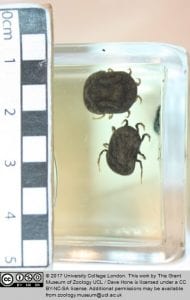Who wants to adopt a parasite? Or, terror and disgust in the Grant Museum.
By uclznsr, on 12 July 2017
Of all the creatures, critters, beasts, birds, and baleens in UCL’s Grant Museum, few organisms are as ignored and maligned as the parasites. Visitors tend to skirt their north-easterly facing cabinet, either because they have begun their journey around the opposite side of the museum’s horseshoe layout or to bathe in the light of the museum’s “micrarium”; either way, they are not stopping to dwell for long in front of the roundworms, flatworms, or flukes. Likewise, these “helminths” are amongst the least popular candidates for adoption, which allows visitors to have their name displayed beside their specimen of choice in exchange for a contribution to the museum’s conservation, renovation, and documentation projects. There is a gruesome irony here, since tapeworms can also dwell in the gastrointestinal tract of a human museum visitor for two decades completely unnoticed – and grow up to 55 feet long.
This fact might go some way to explaining why visitors seem to prefer more orthodox – and straightforwardly threatening – specimens. They seem to have little problem with, are even fascinated by, lions, sharks, jellyfish, scorpions, and other animals whose attacks can be painfully and violently fatal to humans. But parasites, whose methods are comparatively insidious, seem implicitly to repel. Visitors to the Grant Museum seem to prefer, therefore, threats which are visible and whose assault we can see coming, rather than incursions upon our safety from an invisible and undetectable enemy. They are not alone in this, of course: the fear of that which cannot be seen, or refuses to be revealed, is not merely an expedient workaround for low-budget horror films, but permeates folk-tales, fairy-tales, and mythology, across the world.
Nevertheless, our revulsion of parasites in particular – and not merely of what is invisible – must itself have a less visible cause, because parasites themselves are not always hidden. Organisms like the tick and the leech feed off and derive nutrients at the expense of their host, and are certainly not invisible as they do so. An infamous scene from the film adaptation of Stephen King’s Stand by Me acts as a testament to the terror the latter species seems to evoke.
Perhaps, then, it is less what is invisible or visible and more a political economic fear – a question of ownership. After all, the parasite yields profit from our bodies, without offering anything in exchange, and often without having the good grace to let us know. Can we even claim to own our own bodies, if they are so easily exploited by these organisms? One man, Dimitri Tsafendas, was certain that a parasite had taken ownership not only of his body but his mind when in 1966 he assassinated the prime minister of South Africa, Henrik Verwoerd. Tsafendas was convinced a tapeworm he had as a boy was still present in his system, and was dictating his every action.
This killing represents an uncanny reversal. Verwoerd is known today for his role as the “architect of apartheid” and the discourses and justifications of racism have often drawn upon the notion of “the other” as a parasite, whose incursion on the body politic represents the threat of impurity, disease, and the loss of national ownership. Verwoerd himself became the victim of such a delusion, albeit on the personal, individual scale. Tsafendas, despite his claims, was deemed criminally insane.

Ticks, J135, The Grant Museum of Zoology
Other theories also allow us to speculate why the parasite exerts such a hold upon the human psyche. The French psychoanalyst Didier Anzieu argues in his The Skin Ego (Le Moi Peau) that the biological protection offered by the bodily ‘wrapping’ of our skin is doubled by a psychic defense mechanism which guards against penetrations of and assaults upon our identity sense of self-unity. To feel revulsion or horror at the sight of a tick burrowing itself into one’s arm, therefore, is not merely because it represents a threat to our biological well-being; our disproportionate terror is a result of the sense of being attacked on a deeper, existential level, an infiltration of the very boundaries that allow us to constitute ourselves as sovereign, unified psychic beings.
This theory complements another psychoanalytic theory, Julia Kristeva’s notion of abjection. She contends in The Powers of Horror that our revulsion at the abject is in fact a way of shoring up the very self-identity, unity, and sense of psychic wholeness that it appears to threaten. This is achieved by “abjection”, the sense of relief and pleasure at ejecting from the body that which is perceived to be impure of dangerous. In this way, she argues, we not only resist assimilating what appears to us as an assault on our being, in doing so ‘I expel myself, I spit myself out, I abject myself within the same motion through which “I” claim to establish myself.’
Parasites, then, for all that we seem to want to ignore, are for that very reason integral to understanding who we believe we are as human beings. They are what we believe we are not. We are honest; we are visible; we do not take without giving back; we own and control ourselves and in turn respect the self-ownership of others, as long as they too remain in control of themselves. But we do not need the exemplar, historical context, and outcome of Dimitri Tsafendas and Henrik Verwoerd to know that these self-descriptions are often self-deceptions. Perhaps it is time to properly regard the parasite.
 Close
Close

